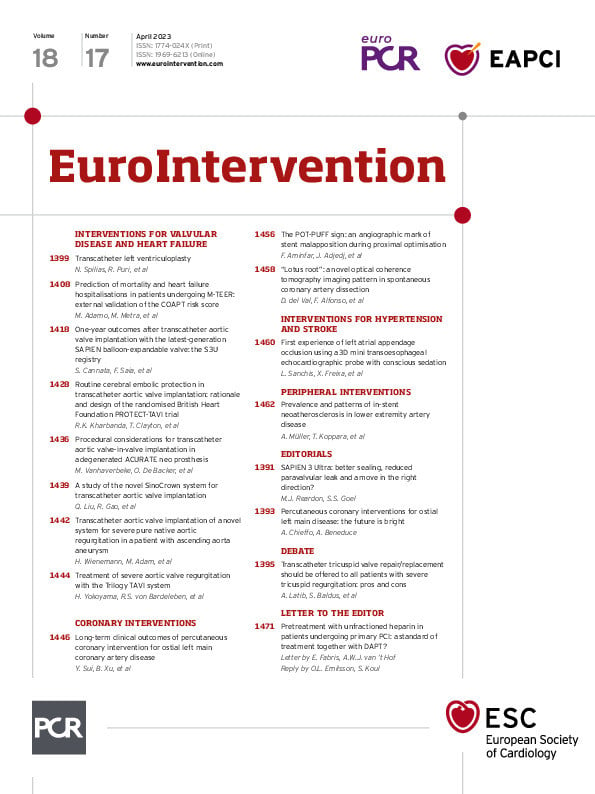The letter by Drs Fabris and van ’t Hof1 raises important questions regarding the potential impact of concomitant pretreatment with dual antiplatelet therapy (DAPT) as well as the time from symptoms to medical intervention in our study exploring the impact of pretreatment with unfractionated heparin (UFH) versus no UFH in patients with ST-segment elevation myocardial infarction (STEMI) undergoing primary percutaneous coronary intervention (pPCI). To explore this issue further, we performed two additional subgroup analyses using our data from the Swedish Coronary Angiography and Angioplasty Registry (SCAAR) (n=41,631; 71% male; with a first-time STEMI event undergoing PCI from 2008 to 2016). Fully adjusted models were used, in accordance with the methods described in the original paper2.
As aspirin is mandated in all clinical protocols in Sweden, patients who do not receive this drug (14% of our cohort) are particularly frail patients who do not represent the overall STEMI population. We therefore decided not to analyse the subgroups with and without DAPT but to focus on patients with and without pretreatment with a P2Y12 inhibitor (clopidogrel, ticagrelor, or prasugrel). Interestingly, there was no statistically significant interaction between these subgroups (Table 1). This finding is in line with the ATLANTIC trial, where patients with STEMI were randomised to prehospital or in-cath lab ticagrelor, and no improvement in pre-PCI coronary reperfusion or ST-segment resolution was shown3. Furthermore, in vitro studies have suggested that only a fraction of the patients treated with prehospital ticagrelor or prasugrel have sufficient P2Y12 inhibition upon arrival in the cath lab4. Indeed, P2Y12 inhibitors are administered orally, and during a STEMI event, alternative ways of administration have been discussed to improve the decreased intestinal absorption5. In addition, the randomised ACCOAST trial showed that pretreatment with prasugrel in non-ST-segment elevation myocardial infarction (NSTEMI) did not reduce ischaemic events but increased major bleedings6. Although STEMI and NSTEMI are not the same condition, they share an underlying pathogenesis.
As the time from symptom onset to medical intervention is not available in SCAAR, we based our estimate of this delay on the time from symptom onset to electrocardiogram (ECG), the latter assumed to be close to the administration of UFH. Using this estimate, there was a statistically significant interaction for the mortality outcome, suggesting that the effect of UFH may be more beneficial if administered early (Table 1). Although residual confounding cannot be ruled out, this finding supports an early pretreatment strategy in STEMI, which has also, in a recent observational study, been shown to be beneficial for reperfusion and infarct size7.
We agree with Drs Fabris and van ’t Hof that international collaborative research efforts are warranted to improve prehospital management of STEMI patients. Randomised controlled trials investigating the value of early UFH could add valuable insights.
Table 1. Fully adjusted subgroup analyses, including p-values for interaction, regarding risk ratios (95% CI) for coronary artery occlusion, mortality, and bleeding (UFH versus no UFH). Statistically significant results are bolded.
| Occlusion | Mortality | Bleeding | |||||
|---|---|---|---|---|---|---|---|
| RR (95% CI) | p-value | RR (95% CI) | p-value | RR (95% CI) | p-value | ||
| Pretreatment with P2Y12 inhibitor | Yes | 0.88 (0.85-0.91) | 0.18 | 0.89 (0.77-1.02) | 0.62 | 0.96 (0.80-1.15) | 0.19 |
| No | 0.93 (0.86-1.01) | 0.82 (0.63-1.07) | 1.24 (0.87-1.75) | ||||
| Time from symptom onset to ECG | <1 hr | 0.86 (0.82-0.90) | 0.21 | 0.73 (0.58-0.91) | 0.03 | 0.98 (0.74-1.29) | 0.77 |
| ≥1 hr | 0.89 (0.86-0.92) | 0.95 (0.82-1.10) | 1.02 (0.85-1.23) | ||||
| CI: confidence interval; ECG: electrocardiogram; RR: risk ratio; UFH: unfractionated heparin pretreatment | |||||||
Conflict of interest statement
The authors have no conflicts of interest to declare.

